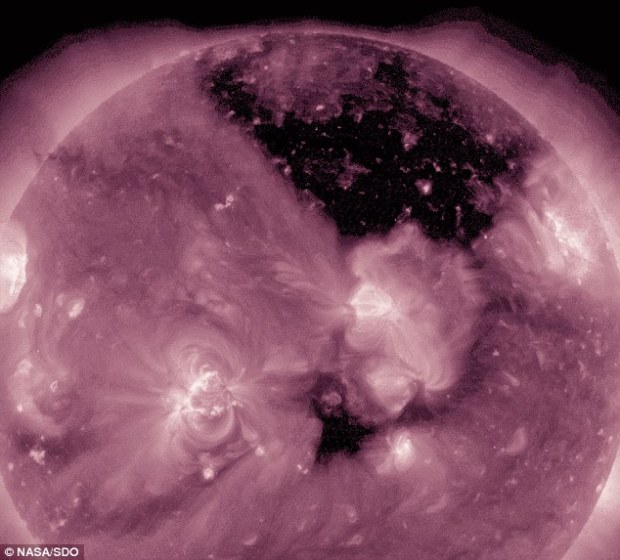
NASA Spotted Two Massive Black Holes On The Sun. Are We in Trouble?
NASA’s Solar Dynamics Observatory (SDO) has spotted two huge black marks called “Coronal holes”, creeping across the surface of the sun. “These coronal holes are important to understanding the space environment around the Earth through which our technology and astronauts travel,” NASA said in a statement.
Coronal holes are low-density regions of the sun’s atmosphere, known as the corona. Because they contain little solar material, they have lower temperatures and thus appear much darker than their surroundings. Coronal holes are visible in certain types of extreme ultraviolet light, which is typically invisible to our eyes, but is colorized here in purple for easy viewing.

While the coronal hole in this ultraviolet image taken by NASA’s Solar Dynamics Observatory looks terrifying, it won’t harm us. There’s nothing to worry about, the scientists promise.
Coronal holes are the source of a high-speed wind of solar particles that streams off the Sun some three times faster than the slower wind elsewhere. These solar winds can not only create geomagnetic storms on the Earth which can disturb communications in all forms but also affect astronauts’ on deeper space mission like Mars in the near future.
On May 17, NASA announced that the SDO discovered two Coronal Holes on the surface of the Sun. One of them is the biggest seen in decades which is about “six to eight percent of the total solar surface,” according to a report by NASA.
.@NASASunEarth‘s #SDO saw a long coronal hole in the middle of the sun in late March: https://t.co/SpmJjBNicW pic.twitter.com/41bdmVTsw1
— NASA (@NASA) April 9, 2016
The findings of the SDO are important in understanding not just the Sun, but also the space environment in general. It is also used to determine if space travel is possible, since the Coronal holes also emit high-speed solar particles, faster than any part of the Sun.
“While it is unclear what causes coronal holes, they correlate to areas on the Sun where magnetic fields soar up and away, without looping back down to the surface, as they do elsewhere,” said Karen C Fox and Steele Hill of NASA’s Goddard Space Flight Center.